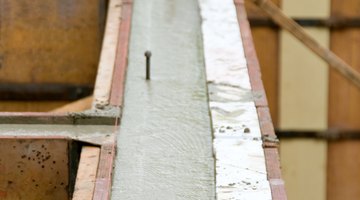Distance Between Construction Joints in Retaining Wall
Construction joints are part of a structure when pours are executed at different times. For retaining walls, the common construction joint is the horizontal, continuous one between the footing and the wall. Vertical construction joints may not be present. Control joints, or planned breaks, are more typical, and are spaced at regular intervals.

Properties of Concrete
Concrete has great compressive strength to resist forces pressing on it, but it's weak in tensile strength, meaning its ability to withstand forces pulling it apart. Tension is applied to concrete from soil movement, such as settling at different rates, or from moisture in the soil and freezing and thawing. Retaining walls are also subject to lateral pressure from the soil being retained. Concrete cracks when its capacity to resist tension is exceeded. Installing joints in the concrete is one method of controlling the location and width of cracks.
Types of Concrete Joints
The three main types of joints are contraction, isolation or expansion and construction joints. Contraction, or control, joints purposely install a point of weakness in the wall where cracking can occur without affecting the structural integrity of the wall. Expansion, or isolation, joints separate sections of walls so they can move independently and avoid pressures from moving together. Construction joints separate concrete work poured at different times. They can be vertical and horizontal.
Construction Joints in Retaining Walls
The main construction joint for retaining walls is the horizontal joint between the footing and the wall -- stem -- of the retaining wall. The footing and wall are typically poured separately. The footing often includes a keyway, or slot, formed in the top of the footing to increase the wall's sliding resistance. The joint between the footing and the wall is continuous as it extends for the length of the wall and footing.
Distance Between Joints in a Retaining Wall
Vertical construction joints are not standard for retaining walls unless separate pours are required. Contraction -- control -- joints are placed vertically at regular intervals to control cracking from expansion and contraction from soil movement. Usually, control joint spacing is specified for a minimum of 20 feet on center.
References
Photo Credits
- Jupiterimages/Photos.com/Getty Images
- Jupiterimages/Photos.com/Getty Images
More Articles


